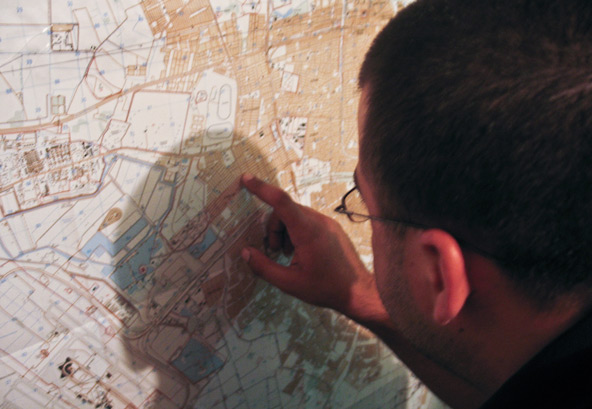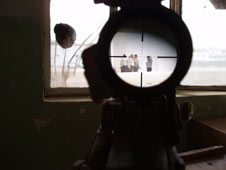
Iraq, June 2005. Ayman Salihee pointing out where his older brother Dr.
Yassir Salihee was killed by Romero at a checkpoint accident. I embedded with the U.S. military to understand what happened to Salihee and Romero related the whole story from his point of view.
Photo: Phillip Robertson
When I asked Joe about the total elapsed time between the warning shots and the lethal shot he said, "The total elapsed time was 6 or 7 seconds." When Joe talked about his decision to fire at Salihee, he sounded anguished, but he kept coming back to the moment when Salihee passed the first car, the moment he decided that Salihee was a bomber attacking the U.S. position.
Two Iraqi eyewitnesses contradicted Joe's account. Falah Hassan Jasim, a plumber who was standing on the south side of the street when the shooting happened, told me, "There was a Lada car turning in the road and he [Salihee] tried to pass it, and then he pulled over. The Americans shot him, they were standing in the middle of the street." According to Hassan, Salihee was stopped with his hands up when the snipers fired at him. I asked Hassan about the interval between the shots and he said, "It was like this, pop, pop, pop," saying the bullets were fired in less than a few seconds.
Another witness, Hamid Mohammed Aboud, a 25-year-old ice seller who works at the corner of Amel Al Shabi and Rafaee streets, said, "Both Americans were firing at the same time, the shots were very close together." When the shooting started, the ice seller said he ran to seek shelter in a nearby store. "I am talking about this because I might be in the same place one day."
Was Salihee's car stopped? There does not appear to be definitive proof one way or the other. Ayman Salihee, Yasser's younger brother, said that when he arrived at the intersection, he saw that the Espero's transmission was in neutral and that his brother's feet were on the brake. In the police report, a diagram shows that Salihee's car was pulled all the way over to the left side of the street, parallel to the curb.
The evidence suggests that Salihee might have had his hands raised. Four fingers on Salihee's right hand were missing. Although it's possible that a bullet other than the fatal bullet caused the injury (there were conflicting stories that an Iraqi soldier might also have fired), the missing fingers and the angle of fire are consistent with a bullet striking a raised hand.
The details may be murky, but in retrospect it is fairly clear what happened. The real problem was that the platoon did not put out cones and wire -- if they had Yasser would have stopped. Then came the fateful turning car, followed by another car coming around it. The soldiers were on edge, but they seem to have followed their rules of engagement. It was a typical misunderstanding, of the sort that happens all the time in Iraq.
After Joe fired at the windshield he walked to the car and saw that Salihee was covering his eye with his right hand, but as he watched the hand fell and blood poured from the wound in the man's head. Not long after the shooting, Joe's unit left the area. "We had to leave the scene and that was fucked up, but we had to continue our mission. Then we came back and I saw the lady crying and it got to me because I'm not out here to kill innocent people at all. When I saw her, that's when I knew something was wrong." The woman Joe saw was Raghad Salihee, Yasser's wife, and in our conversation he returned several times to the moment he saw her near Salihee's car. It's an image that deeply troubles him.
On 2nd of July, before I found the sniper, Ayman had taken me out to the Salihee house in Saydiyah where I met Raghad Salihee for the first time. She is a lovely woman, also a physician. When we arrived, the entire family was in mourning. Raghad came into the living room and she was weeping when she said, "If I find the soldier, I will kill him." After I came back from the embed with Joe's unit, I spoke to her at the hotel about the killing of her husband. She spoke calmly as her daughter played nearby. "I want many things but I want the Americans to stop running in the street, they are killing anyone. I also want them to stop using these types of destructive bullets. I see the injuries in the hospital. If a bullet strikes someone in the abdomen or leg, the person dies. If they are shot in the brain, they die immediately."
Raghad went on to say, "I want the Americans to go back to America, but I know they won't go." She asked me if I knew a lawyer in the United States who could take her husband's case. As her daughter gazed hypnotically at the hotel pool, Raghad said, "Can you help me? Please, can you help me?"
Yasser Salihee's name has been added to a steadily growing toll of civilian casualties of the Iraq war. A Web site, Iraqbodycount.net, has estimated that at as many as 26,000 civilians have been killed since the invasion. Because the organization compiled the number from verified news reports, the true toll is higher, since not all of the civilian casualties appear in the press.
The Army is conducting an investigation of Salihee's shooting, as it does in all shootings of civilians that result in death. Considering the murky circumstances and the Army's rules of engagement, it seems unlikely that any disciplinary action will be taken. In an interview with the Los Angeles Times, the spokesman for coalition troops in Iraq said he did not know of any soldier who had been punished for shooting a civilian in traffic or at a checkpoint.
One day in early June, Yasser found a set of X-rays in my hotel room. He said, "Hey, man, what are you doing with X-rays?" I explained that they belonged to a boy named Rakan Hassan, who was wounded by American soldiers when they fired on his parents' car in Tal Afar earlier this year. The boy's parents were killed. Yasser held the X-rays up to the light and read them, pointing out the fractures and the damage to the boy's spine. This was the moment I learned he was a doctor, that he could do more than report the news and find sources for stories. Yasser would put down his notebook and help tend to wounded people. Yasser Salihee's talents were not solely his own, they reached beyond him, into possibilities for his wounded country. But his future is gone, and with it goes a measure of hope for Iraq.
Before I left Joe at his company headquarters at Camp Victory, he said he wanted to
tell the Salihee family he was sorry and that he'd never had to fire to stop a car before
the 24th of June. "If I'd seen his hands up, no way would I have fired a shot. We didn't
murder him. No way was it murder," Joe said. But there was desperation in his voice, as if
he wasn't sure.![]()
The Editor and Publisher called the Victim and the Killer one of the most remarkable stories to come out of Iraq.
 LEAD IMAGE: Iraq, 2005. Joe Romero looks through the sight of his sniper rifle at a group of men.
LEAD IMAGE: Iraq, 2005. Joe Romero looks through the sight of his sniper rifle at a group of men.Photo: Sergeant Joe Romero
© Phillip Robertson, 2009-2014.
